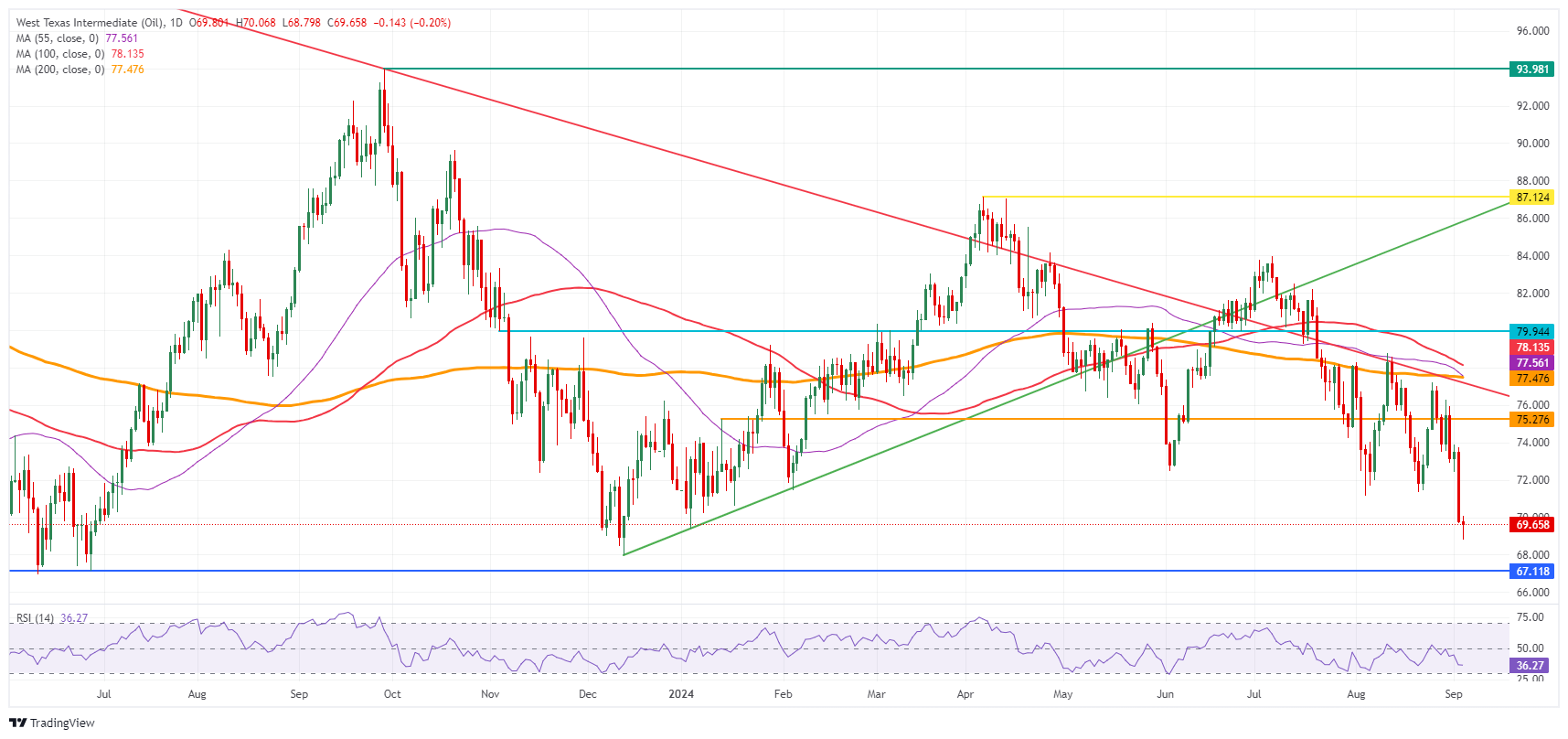- Crude oil is trading significantly lower after several hurdles emerged on Tuesday.
- The disruption in Libya is expected to be resolved, while recession fears in China and Europe weigh on the demand outlook.
- The US Dollar Index is trading above 101.00 ahead of the US jobs report on Friday.
Crude oil is struggling to find support around $70.00 on Wednesday, extending losses after Tuesday’s 5% drop that left oil trading at its lowest level so far this year. Several headlines emerging on Tuesday proved too much for oil traders, sending the black fuel into a selling spiral. The hurdles are twofold, occurring on both the demand and supply sides of the equation.
On the demand side, recent data from China’s Purchasing Managers’ Index showed another severe slowdown in its manufacturing sector, meaning slower demand for oil going forward. Meanwhile, in Europe, one of Germany’s major companies, Volkswagen, has announced plans to close several factories in its home country, a sign that Europe could be facing a severe recession. On the supply side, OPEC is moving ahead with its intention to normalise production, while the political impasse in Libya is almost resolved and could see Libyan oil returning to markets faster than expected.
The US Dollar Index (DXY), which tracks the performance of the US dollar against a basket of currencies, remains above 101.00. All eyes are on this week’s data, with several analysts anticipating that Friday’s US jobs report could be the deciding factor for the US Federal Reserve to cut interest rates, either by 25 basis points or 50 basis points. This makes Friday’s non-farm payrolls release even more important.
At the time of writing, WTI crude oil is trading at $69.52 and Brent crude at $73.21
Oil News and Market Moves: API Drawdown Must Be Massive
- At 20:30 GMT, the American Petroleum Institute (API) will publish its weekly change in crude oil inventories. The previous week saw a reduction of 3.4 million barrels.
- Bloomberg reports that the issue over who should lead Libya’s central bank is about to be resolved, opening up the country’s oil production.
- US crude oil exports have found their way to India, with the US trying to displace Russia from its leading role as the main supplier. According to ship tracking data, nearly $1 billion worth of crude oil has been delivered to India from the US, Business Standard reports.
Technical analysis of oil: Washout
Crude oil’s price action on Tuesday must have hurt many parties. However, traders should not have been surprised by this move considering the recent string of headlines and data that pointed to an imbalance between excess supply – and more supply to come – versus weaker economic data with even some signs of recession. More downside could come before a rebound occurs.
On that upside, the lost level at $75.27 will be the first level to retrace if possible. Next, the double level at $77.55 aligns with a downtrend line and the 200-day Simple Moving Average (SMA). In case the bulls can break above it, the 100-day SMA at $78.54 could trigger a rejection.
On the downside, the August 5 low at $71.17 has been broken. From here, the big figure of $68.00 is the first level to watch, followed by $67.11, which is the lowest point of the triple bottom seen in June 2023.
WTI Crude Oil Daily Chart
WTI Oil FAQs
WTI crude oil is a type of crude oil sold on international markets. WTI stands for West Texas Intermediate, one of three main types that include Brent and Dubai crude. WTI is also known as “light” and “sweet” for its relatively low gravity and sulfur content, respectively. It is considered a high-quality oil that is easily refined. It is sourced in the United States and distributed through the Cushing hub, considered “the pipeline crossroads of the world.” It is a benchmark for the oil market and the price of WTI is frequently quoted in the media.
Like all assets, supply and demand are the main factors determining the price of WTI crude oil. As such, global growth can be a driver of increased demand and vice versa in the case of weak global growth. Political instability, wars and sanctions can disrupt supply and impact prices. Decisions by OPEC, a group of large oil producing countries, are another key driver of price. The value of the US Dollar influences the price of WTI crude oil, as oil is primarily traded in US Dollars, so a weaker Dollar can make oil more affordable and vice versa.
The weekly oil inventory reports published by the American Petroleum Institute (API) and the Energy Information Agency (EIA) influence the price of WTI oil. Changes in inventories reflect fluctuations in supply and demand. If the data show a decrease in inventories, it may indicate an increase in demand, which would push up the price of oil. An increase in inventories may reflect an increase in supply, which pushes down prices. The API report is published every Tuesday, and the EIA report the following day. Their results are usually similar, with a difference of 1% between them 75% of the time. The EIA data is considered more reliable because it is a government agency.
OPEC (Organization of the Petroleum Exporting Countries) is a group of 13 oil-producing nations that collectively decide on member countries’ production quotas at biennial meetings. Their decisions often influence WTI oil prices. When OPEC decides to reduce quotas, it can restrict supply and drive up oil prices. When OPEC increases production, the opposite effect occurs. OPEC+ is an expanded group that includes ten other non-OPEC countries, most notably Russia.
Source: Fx Street
I am Joshua Winder, a senior-level journalist and editor at World Stock Market. I specialize in covering news related to the stock market and economic trends. With more than 8 years of experience in this field, I have become an expert in financial reporting.








